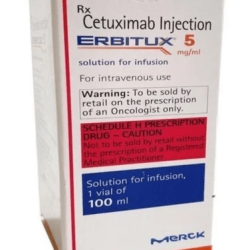Description
Indian Generic Medicines assist you in delivering Dabrafenib capsules across the world as per the customer’s prescribed medication and applicable regulatory approval.
Dabrafenib is a kinase inhibitor used alone for treating patients with unresectable or metastatic melanoma with mutation BRAF V600E and together with medicine trametinib, for:
- Treating patients with unresectable or metastatic melanoma with mutations BRAF V600E or V600K.
- The adjuvant treatment of those with melanoma with mutations BRAF V600E or V600K, and enhancement of lymph node(s), after complete resection.
- Treating patients with metastatic non-small cell lung cancer (mNSCLC) with mutation BRAF V600E.
- Treating patients with locally advanced or metastatic anaplastic thyroid cancer (ATC) with mutation BRAF V600E and with no satisfactory locoregional treatment options.
- Treating adult and pediatric patients aged 1 year and older with unresectable or metastatic solid tumors with mutation BRAF V600E who have progressed after prior therapy and have no satisfactory alternative treatment options.
- Treating pediatric patients aged 1 year and older with low-grade glioma (LGG) with a mutation BRAF V600E who require systemic therapy.
Limitations of Use: Dabrafenib is not for treating patients with colorectal cancer due to known intrinsic resistance to BRAF inhibition. Dabrafenib is not for treating patients with wild-type BRAF solid tumors.
Dosage and Side Effects: The recommended dosage of Dabrafenib in adult patients is 150 mg (two 75 mg capsules) orally twice daily. The recommended dosage for Dabrafenib in pediatric patients is based on body weight. Take the dosage of Dabrafenib at least 60 minutes before or at least 120 minutes after a meal. There is no established recommended dose for Dabrafenib capsules in patients weighing less than 26 kg.
The most common side effects of Dabrafenib capsules as a single agent are headache, pyrexia, arthralgia, hyperkeratosis, papilloma, alopecia, and palmar-plantar erythrodysesthesia syndrome. The most common side effects of Dabrafenib in combination with trametinib include:
- Unresectable or metastatic melanoma: headache, chills, pyrexia, rash, cough, and arthralgia.
- Adjuvant treatment of melanoma: headache, rash, nausea, pyrexia, fatigue, chills, arthralgia, vomiting, diarrhea, and myalgia.
- NSCLC: vomiting, diarrhea, nausea, pyrexia, fatigue, dry skin, decreased appetite, rash, cough, edema, chills, dyspnea, and hemorrhage.
- Adult patients with solid tumors: chills, headache, pyrexia, fatigue, nausea, rash, hemorrhage, myalgia, arthralgia, cough, vomiting, constipation, diarrhea, and edema.
- Pediatric patients with solid tumors: vomiting, fatigue, pyrexia, rash, dry skin, cough, diarrhea, abdominal pain, nausea, dermatitis acneiform, constipation, headache, hemorrhage, and paronychia.
- Pediatric patients with LGG: headache, vomiting, pyrexia, rash, musculoskeletal pain, fatigue, diarrhea, dry skin, abdominal pain, nausea, hemorrhage, and dermatitis acneiform.
Warning and Precautions:
- Hemorrhage, including major hemorrhage defined as symptomatic bleeding in a critical area or organ, can occur when Dabrafenib is used with trametinib. Fatal cases may occur. Permanently stop treatment for all Grade 4 hemorrhagic events and for any Grade 3 hemorrhagic events that do not improve. Withhold therapy for Grade 3 hemorrhagic events; if improved, resume at the next lower dose level.
- Serious febrile reactions and fever of any severity complicated by hypotension, rigors or chills, dehydration, or renal failure, can occur with Dabrafenib. Using Dabrafenib with trametinib increases the likelihood and intensity of fever compared to using Dabrafenib alone.
- Dabrafenib, when used with trametinib, may lead to severe skin reactions like Stevens-Johnson syndrome and DRESS, which can be life-threatening. Monitor patients for new or worsening serious skin reactions. Permanently discontinue treatment for SCARs.
- Due to how it works, Dabrafenib might stimulate the growth of cancers that have a mutated or activated RAS gene. Monitor patients receiving this drug for signs or symptoms of non-cutaneous malignancies. Permanently stop therapy for RAS mutation-positive non-cutaneous malignancies.






